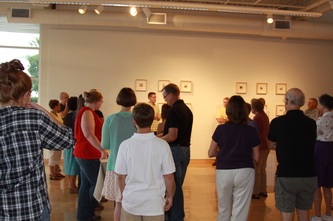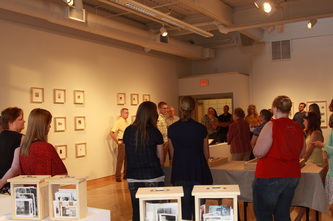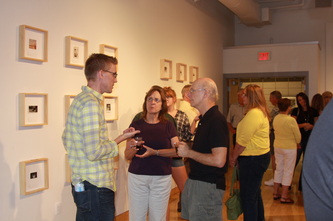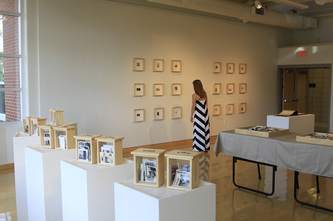 Last week Friday, Karina and I made a flying trip down to Orange City, IA to my opening at Northwestern College. It was a great opening...a good turnout, time with family and friends, seeing former professors, and of course seeing ones art in a new space. As I said that night, any solo exhibition is a great event as an artist but the opportunity to do so in a community that has been so formative in my own life is extremely special. I am so thankful for this opportunity, for family and friends who came to the show, and for Emily Stokes wonderful help in hosting.
0 Comments
The first edition of four of the two volume set that I am tentatively calling Hermeneutics is finished. Like the two books from the MFA show the book uses vernacular photographs as a ploy to examine those things that shape our process of interpretation. These books take that idea into the field of religion and theology by employing a variety of cultural symbols, images, and text to suggest an assortment of differing positions that may guide interpretation. While some are done with a sense of irony and humor, they are intended to be an irenic sort of enterprise as a critique from within the bounds of the church. You can see more here.
Volume 1 begins with a rather provocative quote from Stanley Hauerwas stating, "...No task is more important than for the Chruch to take the Bible our of the hands of individual Christians in North America...[because] they are possessed by habits far too corrupt for them to be encouraged to read the Bible on their own." (Unleashing The Scripture: Freeing the Bible from Captivity to America, p. 15) Hauerwas argues that North American Christians are too swayed by their status as democratic citizens to read the Bible correctly. Hauerwas is after those things that shape, and in this case, distort our readings to texts Last weekend I printed. Printed. And printed some more for these two books. They will be another set of photo albums like those of from the MFA. Instead of using the translucent pages of the MFA albums, this one uses the traditional black pages with printing in a silvery/black ink. The other books had a mish-mash of images, these two books incorporate 32 different prints wrestling with some aspect of theology or religion in general. The subject matter suggested a fabric change as well. Instead of the black I had used in the past, I went with the magenta. I will probably start shortly inserting the photos into the album and wait to cover the other 3 in the variable edition.
 Well, the show has opened and the reception went off well. If you want to see pictures check out the link below. http://www.facebook.com/media/set/fbx/?set=a.10150164939866574.301637.555701573&l=a16aeaefaa The past week has been a little surreal. Going through this process as a culmination to a degree program is certain to make me reflect not only on this degree, but also to my BA reception back in 1998. Last week as I was putting the final touches on the show, I was listening to Toad the Wet Sprocket, one of my favorite bands from my time in college. I dont listen to them as much these days but would still list them among my favorites. It struck me as one particular album came up in the rotation that I was listening to the same album as I prepared my BA exhibition some 13 years later (how can it be 13 years ago?). I have also been thinking about the ephemerality of art and the art show. UND has but one gallery and this time of year...really for the past 2 months, shows are churned through weekly. Roughly 2 BFA shows share a week and ideally MFA grads get one week to themselves which generally means you install the show on Friday afternoon or over the weekend after the last person has torn theirs down. While setting up the show is stressful and time consuming, it is a tremendous relief to see, in my case, the piles of work, transform the space and begin to embody your ideas. The review came and went without a hitch as did the reception. But already I see Monday, the end to this show coming all too quickly. The show represents the culmination of 3 years of work. For many artists, the work spans their last year or two in the program depending upon the speed with which they work and their medium. For me, this body of work was not begun in earnest until January...41 pieces made in 4.5 months. While many have are more minimal I still had to learn significant skills to reach my vision...namely frame-making and book binding. The center pieces to the show were 2 handmade books...something I had never made before. I've also been thinking about what pushed me down this avenue of work. While there are many reasons, I've come to see the impact of my time in Cyprus with PKAP upon my work. The whole of the archive idea comes my time in the back of museum in Larnaca washing and photographing pottery. Their methods of cataloging and forms of storage (in what in my memory is simple pine trays) became the fundamental construction pieces for the show. My time in those off-limit areas re-affirmed the exclusivity of archives for the trained experts...Something that I tried to bring into the work...and by my own observance in the gallery, it seems to have worked. Having summarized several aspects of Robert Bellah's Habits of the Heart last October, I want to turn briefly to Nathan Hatch’s work in Democratization of American Christianity which should help to create a better vista of how our current doctrines and practice are be compromised by individualism.
Hatch attempts to show how the democratic spirit of early America set the tone for the American church as it took on the spirit of the age. This democratic spirit emerged in three profound ways. First, American’s rejected the traditional separation between clergy and laity where power and virtue was transferred from the educated elite to larger body of individuals.1 Apart from the well educated elite and tradition, individuals were free to explore their “spiritual impulses” thus defining faith for themselves.[2] Filled with democratic hope, Christianity was to become a liberating force for all people from authoritarian structures.[3] From these beginnings, Hatch says that three tendencies emerged for American Christianity: 1) mingling of diverse and contradictory sources, 2) fragmentation, and finally inversion of authority.[4] American religious experience mirrors what was taking place in the name of equality and freedom both at a national level and within its constituents by the systematic and simultaneous raising of the common individual by casting off oppressive authority and placing that authority into the hands of each person.[5] A largely untrained people became the prime interpreters of scripture, now taken from the oppressive hands of educated clergy revealing a populist common-sense or self-evident hermeneutic. [1] Nathan O. Hatch, The Democratization of American Christianity (New Haven: Yale University Press, 1989), 9. [2] Ibid., 10. [3] Ibid., 11. [4] Ibid., 35. |
Ryan StanderArchives
January 2018
Categories
All
|

















 RSS Feed
RSS Feed
